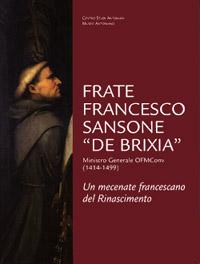Frate Francesco Sansone 'de Brixia' Ministro generale OFMConv (1414-1499). Un mecenate francescano del Rinascimento

Dal 1475 Ministro generale dell'Ordine francescano, frate Francesco Sansone "de Brixia" ha lasciato splendidi segni nella committenza artistica. Grazie alla pubblicazione dei Regesta Ordinis Fratrum Minorum Conventualium relativi al secondo mandato del suo ministeriato (1488-1499), si è potuto far luce sul contributo della sua attività all'interno dell'Ordine francescano e offrire ulteriori dati della fitta rete di rapporti che questi intrattenenva, nonché ricomprendere la sua figura di grande mecenate rinascimentale. Un mecenatismo certamente sorprendete per un successore di san Francesco d'Assisi, ma comprensibile nel contesto del tempo in cui operò, stagione di grande effervescenza e vivacità. Oltre una conoscenza erudita del francescanesimo, a parlare efficacemente di frate Francesco Sansone sono i monumenti e documenti d'arte da lui commissionati in grandi centri della storia francescana: Assisi, Padova, Firenze, Brescia. Luoghi già noti e documentati per la committenza sansoniana, riproposti ora in questo volume che, oltre a ritracciare un dettagliato profilo che tiene conto anche dei recenti contributi, offre una visione unitaria gli interventi voluti da questo ministro generale francescano.
The volume, enriched by a considerable number of photographs, has the purpose of celebrating the fifth centennial of the death (1499) of Fr. Francesco Sansone da Brescia, who was general minister of the Franciscan Order from 1475 until his death. A series of essays presents the biography and work of this refined and cultured man, an unknown benefactor, who had ties with the circle of the Della Rovere family (with the most significant representative of the family, the Franciscan Pope Sisto IV). His was a patronship that was expressed on behalf of various Franciscan centres, which were important seats in the history of the Order, such as Assisi, Padua, or other localities where he resided during his life: Siena, Rome, Florence, Brescia. Lorenzo Di Fonzo, who started from well-known documentation, traces Sansone's biography, attempting to disentangle the much-discussed question of his family origins. Giovanna Baldissin Molli analyses his work in Padua, as well as the numerous works inside the Anthonian basilica, with the most "obvious" document of the Chapel of the Ark. Silvestro Nessi turns his attention to Assisi, which owes the wooden choir of its Upper Basilica to Sansone's generosity, as well as the great door of the Lower Basilica. The Franciscan community of Brescia always had great affection for the heart of Sansone. The works that he commissioned are numerous, but according to Pier Virgilio Begni Redona, the altar-piece originally commissioned from Leonardo da Vinci and executed by Romanino after the death of Sansone commands particular attention. Marco Collareta analyses a splendid processional cross, for the execution of which the Franciscan left a conspicuous sum of money in his last will and testament. Michela Benetazzo presents the seventeen great illuminated choir books, commissioned for the new choir by the Brescian Church of Saint Francis.
Archivum Franciscanum Historicum, 2003, p. 254-256
Collectanea Franciscana, 71, 2001
Medioevo Latino, XXIII, 2002
Notiziario Bibliografico, regione Veneto 40 (Sett. 2002), 10-11

